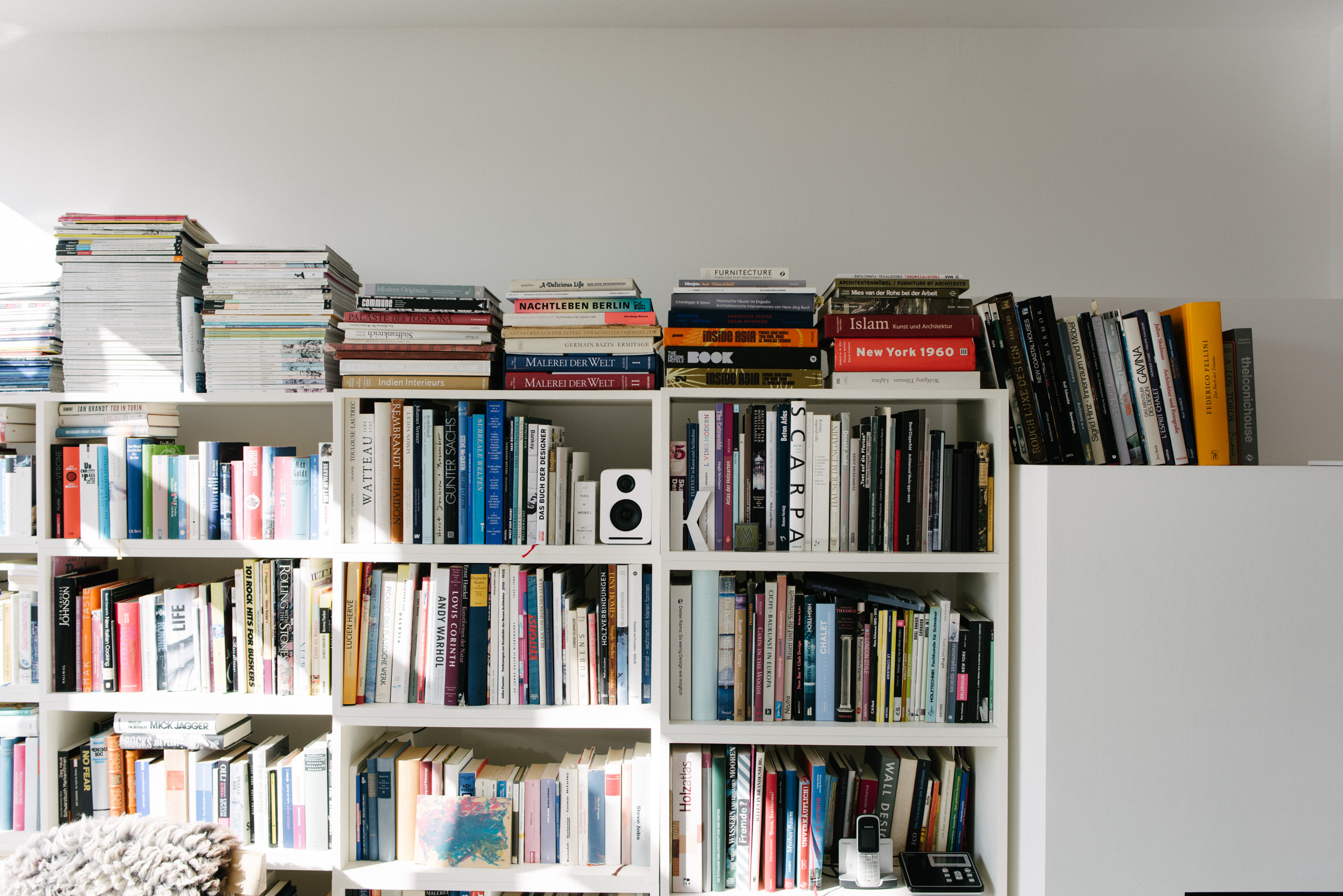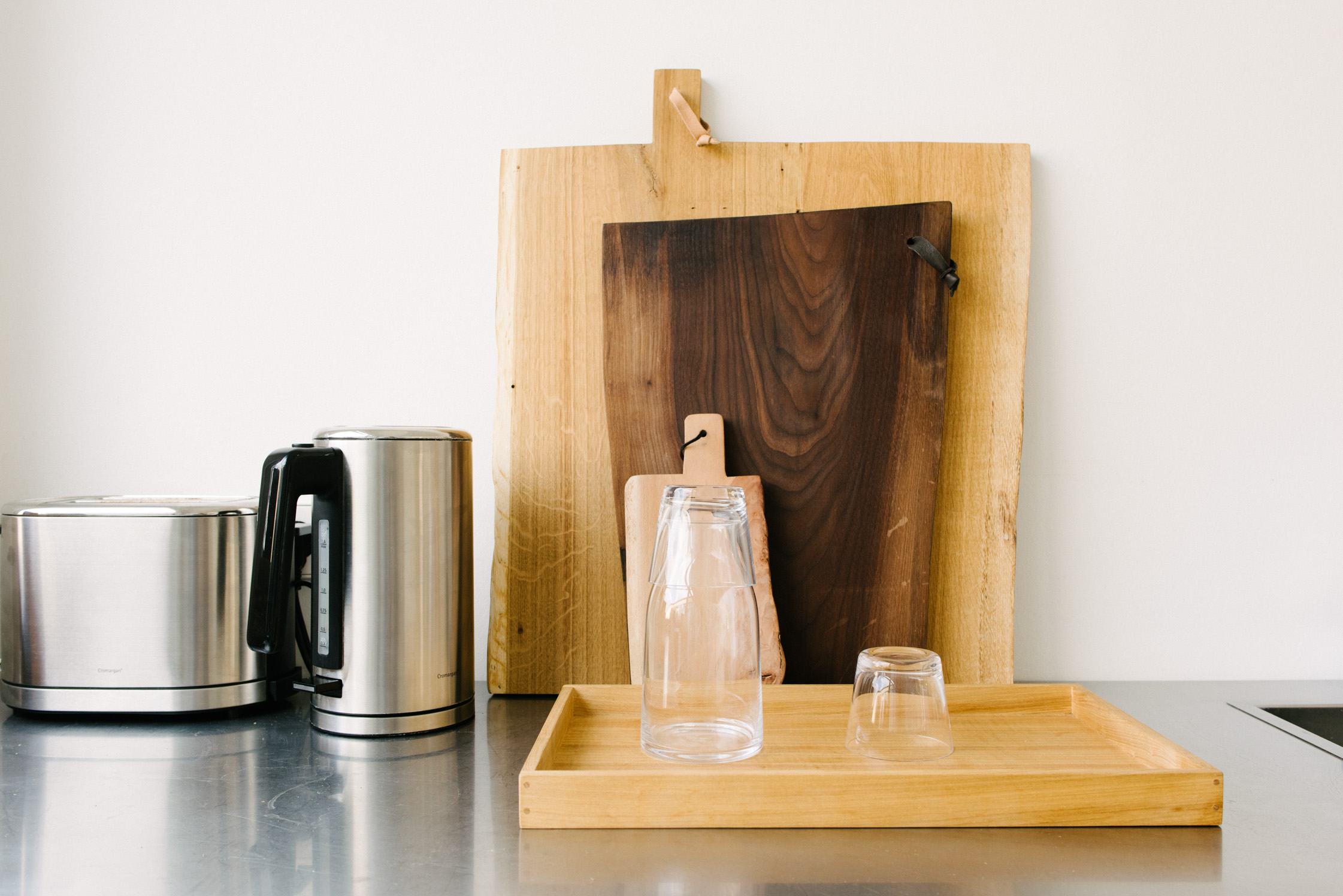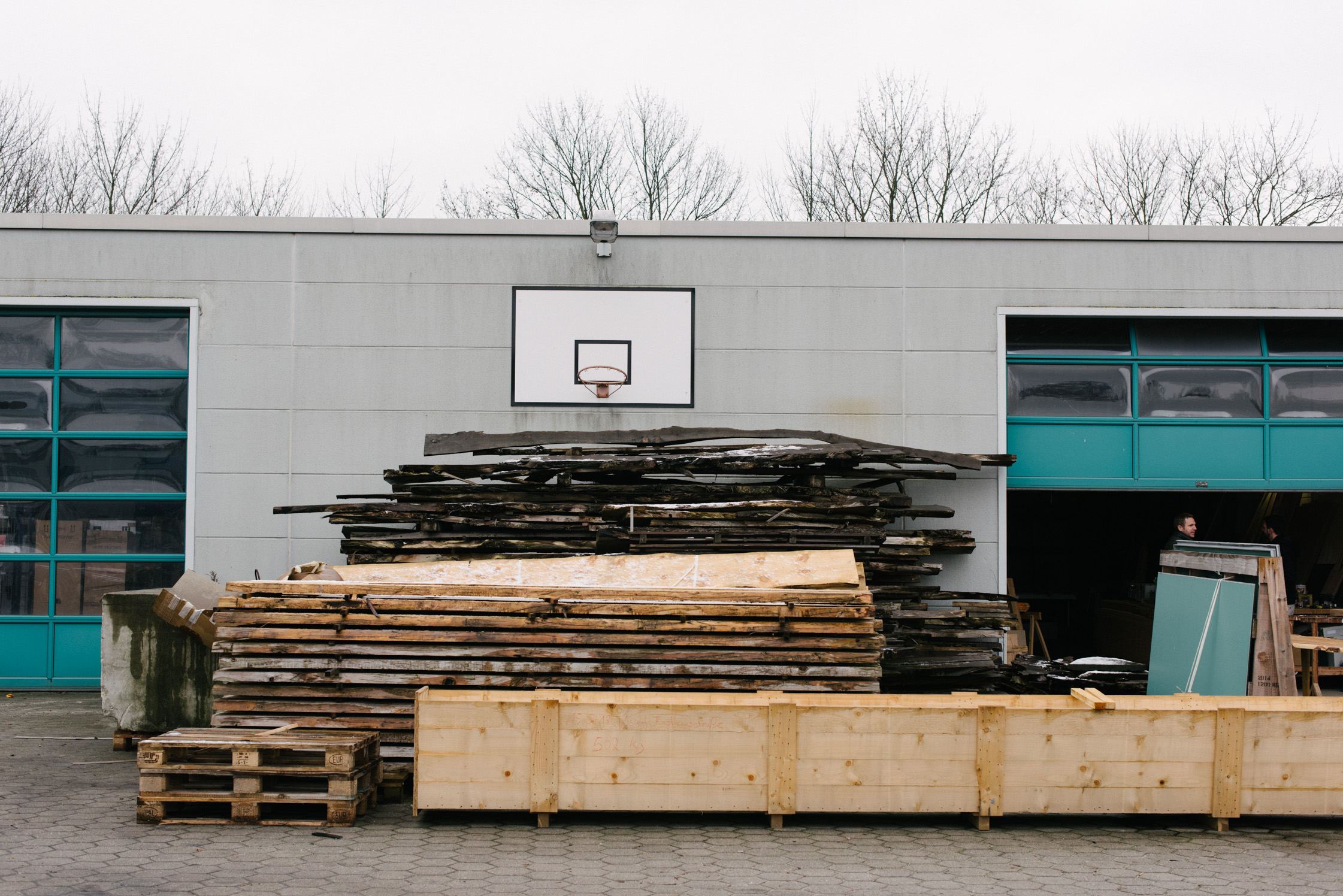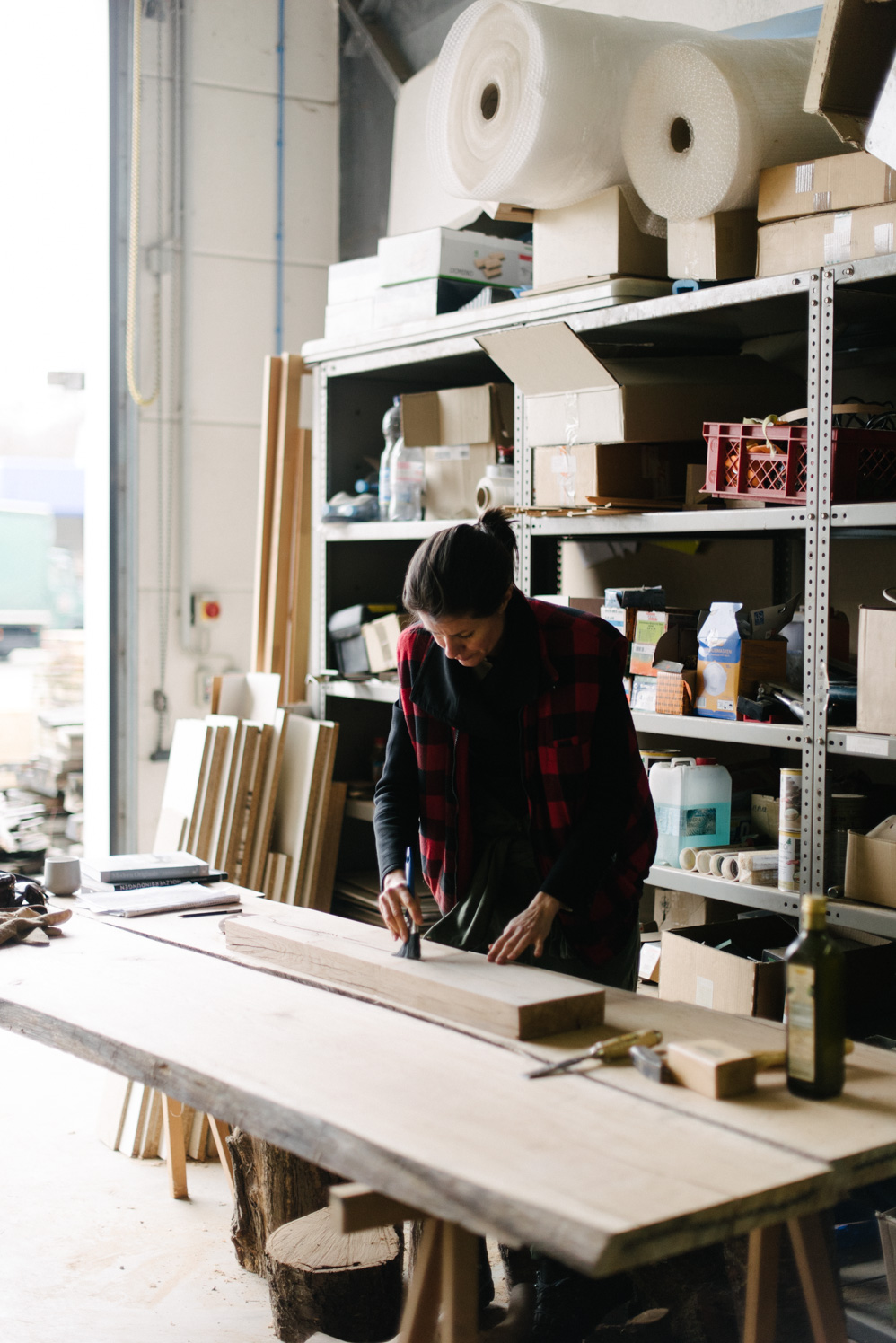The home of furniture and product designer Katja Buchholz and her husband Alex Meschkowski is both an urban oasis and experimental lab.
In their apartment, with its light concrete flooring and breathtaking rooftop terrace, the two creators of furniture manufacturer Buchholzberlin test out Katja’s designs for their functionality and wear resistance, sometimes for months at a time. In the end, everything has to live up the Buchholzberlin principle—that furniture and everyday objects should not only fulfil their function and last, but also get better with age.
A large portion of their range is produced in workshops in Brandenburg. Everything is then sold at Laden in Mitte, Berlin, where Buchholzberlin run a hybrid showroom and restaurant with Lokal. The couple succeeded in creating a warm atmosphere in a space that used to be a ballroom. Living up to the history of its forebear, high-end design is married with hints of rustic charm. Everything used by the guests during lunch or over a glass of wine can also be purchased.
We spoke with Katja and Alex about their passion for wooden materials and Buchholzberlin’s history. Afterwards, the couple invited us to visit Katja’s workspace in Großbeeren, Brandenburg, where everything the designer draws up by hand comes to life. At the moment, it’s home to a particular treasure: spruce logs from David Chipperfield’s impressive exhibition “Sticks and Stones” that was displayed in the Neue Nationalgalerie in the winter of 2014. The logs will soon be crafted into limited-edition tables.




-
Katja, before we speak about Buchholzberlin, could you tell us about your background as a designer and artist?
Katja: I first studied architecture here at the Hochschule der Künste in Berlin. I’ve also always been interested in restoration and had initially wanted to become a restorer. In hindsight, I’m really happy to have chosen a creative path, restoration is a really back-breaking job—you do everything at the object’s will. But, nevertheless, it was hugely lucky that before I studied architecture I had completed an internship with a restorer; the day after I finished my studies I heard that David Chipperfield’s studio were looking for people with some knowledge of restoration. David had come to Berlin specifically for the renovation of Berlin’s Neues Museum and the next day I had a job there!
-
How did it feel to start working on such a prestigious project all of a sudden?
Katja: It was huge. Of course, I’d admired David’s work for a such a long time. I worked there for six years, mostly on the renovation of the Neues Museum. It was an amazing job—it’s one of the most beautiful buildings in the world. I also organised parties for the office at the museum, that people from all around the world were invited to. They came in long gowns and sometimes huge grand pianos were lifted in. We set up huge tables in the space with lavish floral arrangements. Then it was all dancing and partying.










-
What drove you to leave your position and start up something of your own?
Katja: Working on the Neues Museum was a challenge. We drew up restoration plans—that in some cases took years to be interpreted in the build. I was craving to do something with my hands and experience the creative execution more directly. So, when the Neues Museum was finished, I then worked on more interior projects and made my first table. At some point after that, I decided just to give it a go.
One or two years ago, I got a call from David [Chipperfield] asking whether I could also make some furniture for his new building in Joachimstraße. We then sat down and designed some things together, and I also designed on my own and a few great pieces came about from this. One of these was a big table that we made out of the wooden stakes that had been stuck into the ground underneath the Berlin City Palace.












-
It sound likes your work for the studio crossed over pretty seamlessly into your personal work…
Alex: That’s where I come into play. I’m a business lawyer and I consult companies, also when they’re starting out. The development of Buchholz—it’s been about ten years now—didn’t just happen on the drawing table. Personal contacts and conversations with our network of friends and acquaintances were far more important.
I can give you a good example from when we still had a showroom here in Münzstraße. At the time we didn’t feel it really suited us to have a shop that was always open. So Katja said, ‘Okay, we’ll open up on Saturdays from 12 to 2.’ But then when it got to just before 12 on a Saturday we’d have other priorities than overseeing the showroom. Four weeks later we were told, ‘You know, someone who really wanted to speak to Katja came by and there was no one here.’ It turned out it was Herbert Grönemeyer, who had been trying to get onto Katja for four weeks! [laughs] A beautiful table for him came out of this.
-
Classic marketing isn’t quite your thing then…
Alex: The best marketing strategies sometimes have absolutely nothing to do with textbook marketing at all. It has to be something that is in tune with your own life. At the same time you shouldn’t undervalue that we operate in a market where you have to make yourself heard, even people like Katja who design in a restrained and minimal way. We don’t have a signature piece that immediately comes to mind. Our pieces are very reserved companions.






A nose-to-tail eating experience hosted by BUCHHOLZBERLIN
The FvF team recently enjoyed a seasonal, locally-sourced dinner at nearby Laden
-
Katja, where does your interest in the finish of objects and in wood as a material come from?
Katja: A lot comes from my grandmother. She was a pragmatic woman who did all of her own handiwork, sewed and collected the most wonderful things. I spent a lot of time with her, especially outdoors; I grew up near Schlachtensee. We collected mushrooms and she really knew every single tree. Being out in nature and being energized and finding inspiration have been part of the experience for me from the outset. Wood is a great material because it’s warm, comes in beautiful colors and is relatively easy to work with. Each wood brings its own story with it, that I respect when I’m working on it—and so every piece is unique. Because of this it’s often not so easy to predict how a table will look once it’s done. Most of the time, I decide first in my workspace for each individual piece where exactly the legs will be placed or where the table surface will be put together.
Alex: When you sweep your hand over a table, you notice that there’s a sense of liveliness to it. A table like the one in our living room becomes marked over the years, especially when you have kids. Years later you can think back on the changes. Building something like this is so satisfying.
-
You produce a lot in supervised workshops that employ people with handicaps or mental illnesses. Is everything produced there?
Katja: The pieces that have really particular requirements and are really labor intensive—especially prototypes—are built in Großbeeren to make sure we get them exactly as we want. I often work on these pieces myself. These are things like like the seven-meter-long table that we built for the M&C Saatchi agency, for example.
-
You built a seven-meter-long table?
Alex: Yes, and that was a huge challenge, also from the transport side of things. The clients wanted the table to be made from one piece, but could be taken apart in the middle. It’s made up of two roughly six-centimetre-thick oak slabs, each three and half metres long. It also has a grey metal base that can be taken apart. We had to get the table to the third floor somehow!















